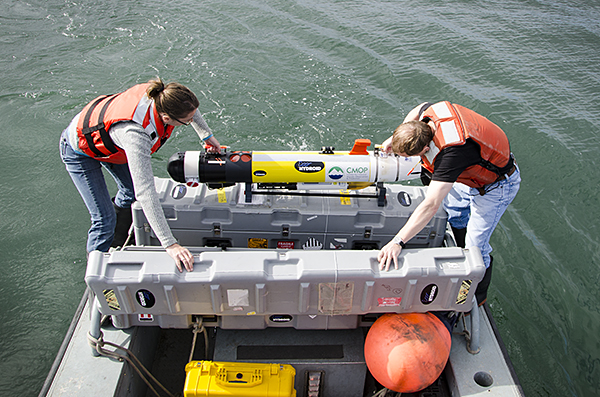You are here
Up Close with a Red Water Bloom

(Craig McNeil, right, and Trina Litchendorf prepare AUV for deployment.)
There I was standing on the stern of the R/V Inferno as it came to a stop in the north channel of the Columbia River estuary. The sky had a broken overcast. The waves slowly rolled past. I wondered if Lewis and Clark - when they finally completed their route to the Pacific Ocean - viewed the same huge blooms of red water that I was looking at in the estuary.
Then Craig McNeil, an oceanographer from the Applied Physics Lab at the University of Washington and CMOP investigator, called out to prepare for deployment. He and his team, Trina Litchendorf and Captatin Andrew Reay-Ellers, were launching an autonomous underwater vehicle, simply known as a AUV.
The AUV is a robot which travels underwater without requiring input from an operator. It is equipped with at variety of sensors that can measure the concentration of various elements or compounds, the absorption or reflection of light, and the presence of microscopic life.
CMOP uses AUVs to study the massive red water blooms in the estuary. The blooms are made up of Mesodinium rubrum - a ciliate that is red in color, swims fast, and blooms during late summer and early fall.
The scientific goal is to characterize the vertical structures of Mesodinium rubrum blooms along the North Channel. This information will help CMOP scientists learn more about how red water species "exploit the small-scale physics and nutritional environment to bloom in a large river-dominated estuary."
It has been almost 207 years since Lewis and Clark first laid eyes on the estuary. I imagine they may have wanted to capture the moment for everyone to see. Well luckily I had a small underwater camera with me. I attached it to a pole and put it down along the waterline. As the boat slowly moved forward, the red water splashed over the lens. It was an up close look at how red the bloom can get.
Read more about APL-UW's partnership with CMOP.



